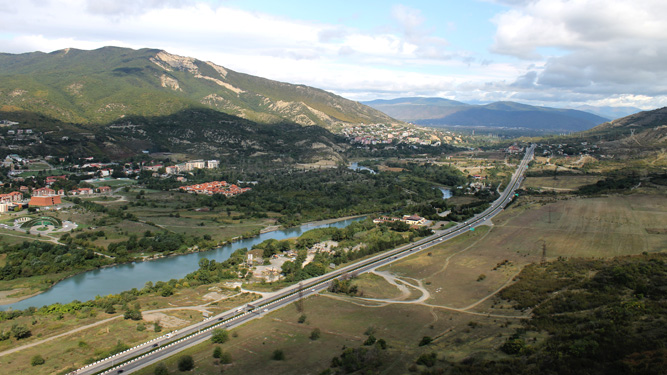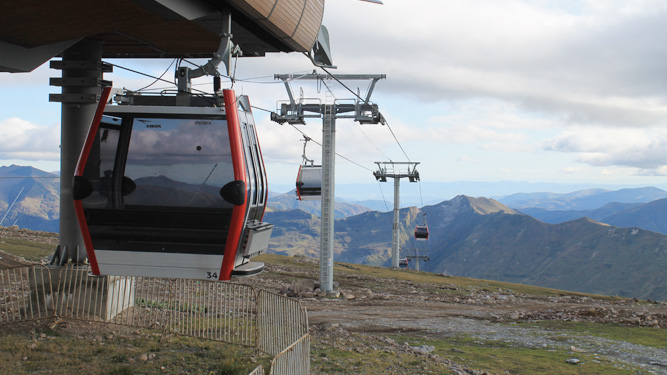
Mtskheta-Mtianeti
WELCOME TO MTSKHETA-MTIANETI
Mtskheta-Mtianeti is one of the most picturesque and diverse areas mtskheta-mtianeti.Providing spectacular views, the landscape sweeps from the majestic 5,000 meter high snowy peaks of the Greater Caucasus and mountain passes, down to beautiful gorges, secluded lakes and alpine valleys. With numerous historical monuments scattered around this small picturesque settlement of just ten thousand inhabitants, it’s no wonder that Mtskheta, the ancient capital of Georgia, deserves its title as one of the UNESCO World Heritage sites and the most important travel destination in Georgia. The legendary Georgian Military Highway, one of the world’s most beautiful roads, winds its way up this region, through steep wooded valleys, up ravines and finally over the 2,300 meter Cross Pass and down again. The area not only takes in the amazing Kazbegi region, home to glaciers, gorges and the 5,047 meter Mount Kazbegi, but also the cultural treasure trove of Khevsureti and Georgia’s most developed skiing resort at Gudauri. Best of all, the whole province is just a short drive away from Tbilisi. There’s plenty to do in the region, from absorbing the culture to creating your own exhilarating adventures. Whatever you’re searching for, there’s something for everyone in Mtskheta-Mtianeti.
CULTURE
Nowhere else in Georgia you can find such diverse cultural and architectural gems as in Mtskheta-Mtianeti. The best examples of this diversity can be seen in the ancient region of Armaziskhevi – Bagineti, the 10th century fortified village of Shatili, the Ananuri complex and the Svetitskhoveli Cathedral. On the base of the 4th century church a stone Basilica building was where built in the5th century. Present cross cupola church was where built in the 11th century by King George I. Inside of it you can still find the column bases of the 5th. c. basilica. And if you’re after an unforgettable adventure these UNESCO heritage sites are not to be missed: Mtskheta and Jvari monastery also the fortified villages in Khevsureti, the 14th. c. monastery of Gergeti Sameba (over 2,200m above sea level) and not to mention the medieval frescoes in Ananuri Monastery.
ETHNO TOURISM
In the Mtsketa-Mtianeti region you can discover the presence of strong ethno-culture, which is best seen and illustrated by its mtskheta-mtianeti, visual arts and handmade crafts. Ancient prehistoric traditions and even clothing are still practiced in the Pshavi, Khevsureti and Khevi regions. While exploring these areas you can travel through the centuries replete with mysterious legends and sayings.
Tours in georgia
For adrenaline-pumping adventures, you can’t do much better than the Peaks of Greater Caucasus. Great for trekking and mountaineering, there are lots of sites to choose from, like the famous 5000m high Mkinvartsveri peak, the spectacular Darial canyon or the Truso gorge. Amateur, medium and professional level trekkers and mountaineers have plenty of choice, and experienced guides are available and recommended. The region also offers amazing locations for mountain biking, horse riding, bird watching, paragliding and rafting, all giving stunning views of the landscape. With dozens of slopes, the ski resort of Gudauri has trails for skiers and snowboarders from beginners to professionals. In addition, the surrounding mountains are a haven for cross-country and off-piste skiers.
PLACES TO VISIT
Mtskheta
Mtskheta, a UNESCO World Heritage Site, has been inhabited since before 1,000 BC and was once the capital of the early kingdom of Iberia, (today’s Eastern Georgia). Just 20km from today’s capital Tbilisi, and situated at the confluence of the Mtkvari and Aragvi rivers, the city is located on an ancient trade route. Archaeologists have unearthed the evidence of Mtskheta’s status as a major trading post. Glass perfume bottles, Greek and Aramaic writings pottery, metalwork and jewellery are all found in abundance beneath the ground here, and many examples are on show in the town’s fine Museum. The ancient geographer Strabo, described Mtskheta as a highly developed city with a water supply system, markets and stone houses. Mtskheta was also the religious centre of the country, with a number of major shrines to Georgia’s pagan pantheon; these would later be replaced by churches when St. Nino converted the country to Christianity in around 337 AD. Although the capital was moved to more easily defended Tbilisi in the 5th century, Mtskheta continued to be the coronation and burial place of Georgian kings, and the seat of the Patriarch, who is also known as the Bishop of Mtskheta. Today, the lovely old town has a laid back, village feel, especially after the more hectic pace of Tbilisi.
The Great Mtskheta Archaeological State Museum-Reserve
The museum-reserve encompasses several different sites from the 4th century BC to the 12th century AD: the Royal residence Armaztsikhe, the Royal crypt, the residence of Pitiakhshes in Armaziskhevi, and the ancient burial grounds of Samtavro. The museum houses an impressive collection of the various archaeological discoveries from the sites.
Svetitskhoveli Cathedral
Located in Mtskheta, Svetitskhoveli Cathedral has been the burial site for Georgian kings and is built on the site where it is said that the robe of Jesus is buried. In 337 AD, when Georgia announced Christianity as its official religion, the first Christian King Mirian was advised by St. Nino, to build a church here, over the grave where Christ’s robe was buried (having been brought back to Georgia by a Georgian Jew, who had bought it off from a Roman soldier at Golgotha). A Lebanese cedar tree growing on the grave was cut down and used to make seven pillars to build the church. However, the seventh and biggest pillar had magical properties which meant that it was hung in the air unsupported, until St. Nino prayed for it to return to earth. This pillar was said to have illuminated light and radiated a lovely fragrance and even a miraculous chrism which could cure many diseases. The pillar was called “Sveti Tskhoveli” – a life-giving pillar – which later became the name also given to the Cathedral. An icon portraying this event can be seen on the second column on the right-hand from the entrance.
Mtskheta Cross Monastery (Jvari)
Jvari is one of the masterpieces of Georgian architecture and is now listed as one of the World Heritage sites by UNESCO. It was built on a hill near Mtskheta overlooking the estuary of two rivers, the Mtkvari and Aragvi. However the original structure was much smaller. After converting to Christianity, King Mirian erected a tall wooden cross on the hill, which was venerated by various Christian nations. Later a smaller church was built beside the church and is now referred to as the Small Cross. However, the church was too small to hold all the visitors and in 586 – 604 AD the larger Jvari cathedral was built over the wooden cross. The pedestal of the old cross has been preserved. Although there are many religious buildings in and outside Georgia with similar architecture you won’t find any that are older and more complete than Mtskheta Cross.
Zedazeni Monastery
One of the oldest pieces of Georgian architecture, Zedazeni Monastery is situated on the left bank of the Aragvi, North-East from Mtskheta. It was founded by Assyrian Father John around 540 AD. With the Southern nave consisting of two parts, the Zedazeni Monastery has been repaired and restored many times, right up until 1971.
Shiomghvime Monastery Complex
Shiomghvime Monastery Complex, one of the most prominent religious and cultural centers in feudal Georgia is located in the Mtskheta district, on the left bank of the Mtkvari. According to historical sources, the monastery was founded by Shio – a apostle of Assyrian Father John of Zedazeni in the 6th century. According to the tradition, Father Shio spent his last years in a dark, deep grotto. He asked in his will to be buried there. His grave is considered a sacred place.
Ananuri Fortress
The fairy-tale Ananuri ensemble is beautifully situated on the Georgian Military Highway, on the shore of the azure blue Zhinvali reservoir. Zurab Aragveli, who is responsible for building much of what is now seen, was a ruthless local prince known for attacking neighboring mountain clans and even blinding his own brother. In spite of this, the complex he produced rates as one of the top sites of Georgia, with two churches and a watchtower squeezed almost impossibly inside massive defensive walls with huge battlements.
Armazi
The original location for the capital of the early Georgian Kingdom of Iberia, mtskheta-mtianeti was once a thriving City. Given its strategic importance located next to the Daryal pass, it has been inhabited since at least the 4th century BC.
Bebristsikhe
This mighty fortress was built on the River Aragvi many centuries ago. It has been the scene of many battles and was the envy of the Iberian Kingdom.
Samtavro Cathedral and Monastery
The Samtavro Valley has been inhabited since the 4th century BC and Saint Nino, who converted Georgia to Christianity, chose this location as her preferred prayer site. The tiny church of St Nino dates back to the 4th century. Since then, Samtavro became the burial ground for the Georgian Royal Family including Georgia’s first Christian King, Mirian and Queen Nana who are buried in the church.
RESORTS AND PROTECTED AREAS
Kazbegi National Park & mountain range
Kazbegi National Park is located on the northern slopes of the mighty Caucasus range and its protected area covers a total of over 8,700 hectares. At 5,047 meters above sea level, Kazbegi mountain (or Mkinvartsveri) is the third highest mountain in Georgia, and is surrounded in myth and religious history. According to the Greek myth, as punishment for teaching mankind how to make fire, the Titan Prometheus was chained to a mountainside in the Caucasus for all eternity. According to Georgian stories, it was the icy slopes of Kazbegi to which he was chained. Prometheus (known as Amirani in Georgia) was apparently imprisoned in a cave 4,000 meters up. The cave, now called Betlemi (Bethlehem), later served as a dwelling for orthodox monks, and was said to contain many sacred relics, including Abraham’s tent and Christ’s manger. Hot springs, acidic and carbonated lakes surround the mountain, and earth tremors are fairly frequent. Covered with 135 square kilometers of glacier, Kazbegi is a great place for ice climbing and mountaineering. The Darial Gorge is an almost impossibly steep cleft in the mountains connecting Russia and Georgia, running for 18km from Stepantsminda to the Russian border at Zemo Larsi. For millennia, this mountain passage has been strategically crucial, and has been fortified since at least 150 BC. In places, the cliff faces are more than 1,000m high, and medieval watchtowers, waterfalls and wildlife make this one of the most incredible roads in the world. The steep valleys either side of the gorge are great places for bird watching. Eagles, hawks and the massive griffon vultures all nest among the rocky outcrops.
Gudauri Resort
Gudauri at over 2,000 meters above sea level, is situated on the Georgian military road near the Cross Mountain Pass of the main Caucasus range, about 120km from Tbilisi. Even in mild winters, Gudauri offers reliable snow cover from November through April. The total length of groomed ski runs are over 20km and are suitable for all skiers, from beginners to experts. Gudauri is well known for its winter activities and hosts ski and snowboard competitions and sports festivals every year. Mtskheta-mtianeti is also a great summer destination, offering bird watching, trekking, horseback riding and rafting
Things do Do IN MTSKETA-MTIANETI REGION
Sno Fortress
Right on the banks of the river Sno, an estuary of Tergi River, sits the village and impressive fortress of Sno. The fortress is in a great position on a stony hilltop, with a pyramidal tower in the centre. Sitting so high up and surrounded by an almost circular wall, it is almost inaccessible. Scholars estimate that it was built in the 16-17th centuries to defend the gorge that contained shorter routes to Khevsureti, Pshavi, Mtiuleti. The fortress belonged to the Ghudushauri family.
Gergeti Trinity Church
This spectacular building says “Georgia” like no other buildings can. The Tsminda Sameba or Gergetis Thrinity Church has been the subject of a million tourist photos, book covers and postcards. Built of massive granite blocks at a height of 2,170 metres, the 14th century cross-domed church and bell tower are an amazing feat of architecture and sheer human dedication. The exterior is richly carved with grape vines, animals and the sun, all of which is covered in a thick layer of startling yellow lichen, almost as old as the church itself. Framed by the magnificence of the snow covered Mount Kazbegi, it’s easy to see why this is one of the highlights of any trip to Georgia. To truly appreciate the view, we recommend hiking from the town of Stepantsminda. Leaving the town, you’ll cross the bridge over the raging torrent of the river Tergi, through the village of Gergeti, and arrive at the church grounds in over an hour. For an easier approach, 4×4 vehicles (which can be rented in the centre of Stepantsminda) take a much quicker route of just half an hour.
The Trusso Gorge
A truly magnificent natural monument, The Trusso Gorge was once a densely populated area consisting of small villages, flat-roofed houses, old districts and fortresses. These villages have managed to survive and maintain their historic appearance and you’ll also find several small 10th century churches scattered around the valley.
Khevsureti
Sheltered by the massive peaks of the greater Caucasus, hidden away from the outside world, there is the extraordinary land of the Khevsurs – Khevsureti. Nowhere else in Europe there is a place that feels so mysterious, unique and magical, a place where ancient pagan traditions survive, and medieval fortress villages guard the secrets of the valleys. Right up until the 1930’s, people here wore chainmail amour and carried swords and shields. The Soviet Union attempted to destroy this ancient way of life, but rituals, songs and crafts are still preserved by the people of this proud, independent land. The main sight in the region is Shatili. This fortress village, next to the Chechen border, has withstood the ravages of time, as well as multiple invasions and sieges. Each four or five storey houses are connected by rooftop walkways that can be taken up if the enemy penetrates the village. One of these towers has been converted into an extraordinary hotel for visitors. The ruined fortress village of Mutso is straight out of a fantasy movie. Poised like a bird of prey on a rocky outcrop at 1,880m above sea level, it has thirty towers and dozens of intact death houses where plague victims would crawl in to die.
Shatili
Shatili is one of the most brilliant masterpieces of Georgian architecture. This village is scattered on the slopes of a rocky hill and served both as a residence and a fortress. For many centuries it served to defend northern passes in the Caucasus leading to Georgia (now restored). The village is lined with closely built tower-houses, which make a solid and inaccessible fortress wall surrounding the whole village. Shatili is linked with the outer world only by a narrow road leading to Arghuni gorge. The architecture is based on terraces of flat-roofed houses and towers, with narrow stone stairs leading to the top between the buildings. The Bridges were used to traverse the village without having to go outside when the enemy invaded. Tsilkani Tsilkani Bishopric Cathedral was founded in the 4th century in the village bearing the same name. The complex includes the Virgin Mary Church and a stone wall of the 8th century. During King Vakhtang Gorgasali’s reign (5th century) a triple-nave basilica was built replacing the older church. ©Georgian National Tourism Administration








